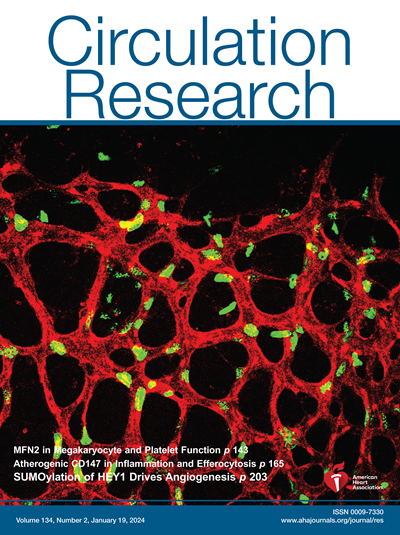Endothelial KLF15/VASN Axis Inhibits Angiogenesis via Activation of Notch1 Signaling.
IF 16.5
1区 医学
Q1 CARDIAC & CARDIOVASCULAR SYSTEMS
引用次数: 0
Abstract
BACKGROUND Angiogenesis is a dynamic process fine-tuned by transcription factors in endothelial cells. The KLF15 (Krüppel-like factor 15)-mediated transcriptional regulation mechanism is critical for cardiovascular diseases. However, the role of KLF15 in governing angiogenesis remains unknown. METHODS KLF15 and VASN (vasorin) were deleted from endothelial cells using tamoxifen-inducible Cdh5 promoter-driven Cre recombinase in EC-KLF15 knockout (KO) and EC-VASN KO mice, respectively. EC-KLF15 KO, EC-VASN KO, and control mice were subjected to retinal angiogenesis or tumor cell transplantation. The RNA sequencing, assay for transposase-accessible chromatin using sequencing, and chromatin immunoprecipitation sequencing were conducted to identify VASN as a downstream effector of KLF15. Cell proliferation, wound healing, tube formation, and sprouting assays were performed to delineate endothelial cell function. RESULTS In EC-KLF15 KO mice and adenovirus-mediated KLF15 overexpression mice, we showed that KLF15 negatively regulated retinal angiogenesis, as confirmed in cultured endothelial cells. KLF15 opened chromatin, bound to the promoters of GC-rich sequences, and transactivated the expression of VASN. Subsequently, VASN suppressed endothelial angiogenic function, which was essential for Dll4 (delta-like ligand 4)-induced Notch1 signaling activation. Moreover, increased expression of VASN in EC-KLF15 KO mice suppressed retinal angiogenesis, which was attenuated by γ-secretase inhibitor. EC-VASN KO mice recapitulated the promotion of retinal angiogenesis in EC-KLF15 KO mice. Finally, the EGF (epidermal growth factor)-like domain of VASN was essential for its interaction with Notch1, and VASN EGF-like domain-derived peptides activated Notch1 signaling and suppressed angiogenesis. CONCLUSIONS The KLF15/VASN axis negatively regulates angiogenesis by activating Notch1 signaling. KLF15 and VASN might represent novel therapeutic targets for the treatment of impaired angiogenesis-related diseases and tumors.内皮细胞KLF15/VASN轴通过激活Notch1信号抑制血管生成
血管新生是内皮细胞中受转录因子调控的动态过程。KLF15 (kr ppel样因子15)介导的转录调控机制对心血管疾病至关重要。然而,KLF15在血管生成调控中的作用尚不清楚。方法在EC-KLF15敲除(KO)小鼠和EC-VASN KO小鼠中,使用他莫昔芬诱导的Cdh5启动子驱动的Cre重组酶,分别从内皮细胞中删除sklf15和VASN (vasorin)。EC-KLF15 KO、EC-VASN KO和对照小鼠分别进行视网膜血管生成或肿瘤细胞移植。通过RNA测序、转座酶可及染色质测序和染色质免疫沉淀测序,确定VASN是KLF15的下游效应体。通过细胞增殖、伤口愈合、管形成和发芽试验来描述内皮细胞的功能。结果在EC-KLF15 KO小鼠和腺病毒介导的KLF15过表达小鼠中,我们发现KLF15负向调节视网膜血管生成,这在培养的内皮细胞中得到证实。KLF15打开染色质,结合到富含gc序列的启动子上,并反激活VASN的表达。随后,VASN抑制内皮血管生成功能,这是Dll4 (δ样配体4)诱导的Notch1信号激活所必需的。此外,EC-KLF15 KO小鼠中VASN表达的增加抑制了视网膜血管生成,而γ-分泌酶抑制剂则减弱了这种抑制作用。EC-VASN KO小鼠再现了EC-KLF15 KO小鼠视网膜血管生成的促进作用。最后,VASN的EGF(表皮生长因子)样结构域对于其与Notch1的相互作用至关重要,并且VASN的EGF样结构域衍生肽激活Notch1信号并抑制血管生成。结论KLF15/VASN轴通过激活Notch1信号负向调控血管生成。KLF15和VASN可能是治疗血管生成受损相关疾病和肿瘤的新靶点。
本文章由计算机程序翻译,如有差异,请以英文原文为准。
求助全文
约1分钟内获得全文
求助全文
来源期刊

Circulation research
医学-外周血管病
CiteScore
29.60
自引率
2.00%
发文量
535
审稿时长
3-6 weeks
期刊介绍:
Circulation Research is a peer-reviewed journal that serves as a forum for the highest quality research in basic cardiovascular biology. The journal publishes studies that utilize state-of-the-art approaches to investigate mechanisms of human disease, as well as translational and clinical research that provide fundamental insights into the basis of disease and the mechanism of therapies.
Circulation Research has a broad audience that includes clinical and academic cardiologists, basic cardiovascular scientists, physiologists, cellular and molecular biologists, and cardiovascular pharmacologists. The journal aims to advance the understanding of cardiovascular biology and disease by disseminating cutting-edge research to these diverse communities.
In terms of indexing, Circulation Research is included in several prominent scientific databases, including BIOSIS, CAB Abstracts, Chemical Abstracts, Current Contents, EMBASE, and MEDLINE. This ensures that the journal's articles are easily discoverable and accessible to researchers in the field.
Overall, Circulation Research is a reputable publication that attracts high-quality research and provides a platform for the dissemination of important findings in basic cardiovascular biology and its translational and clinical applications.
 求助内容:
求助内容: 应助结果提醒方式:
应助结果提醒方式:


